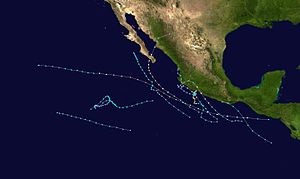| 1996 Pacific hurricane season | |
|---|---|
 Season summary map | |
| Seasonal boundaries | |
| First system formed | May 13, 1996 |
| Last system dissipated | November 11, 1996 |
| Strongest storm | |
| Name | Douglas |
| • Maximum winds | 130 mph (215 km/h) (1-minute sustained) |
| • Lowest pressure | 946 mbar (hPa; 27.94 inHg) |
| Seasonal statistics | |
| Total depressions | 15 |
| Total storms | 9 |
| Hurricanes | 5 |
| Major hurricanes (Cat. 3+) | 2 |
| Total fatalities | 46 direct, 2 indirect |
| Total damage | $813,000 (1996 USD) |
| Related articles | |
The 1996 Pacific hurricane season had below normal tropical cyclone activity, producing 9 tropical storms, of which 5 became hurricanes, with 2 of those intensifying into major hurricanes. With an Accumulated cyclone energy (ACE) index of 53.9, the season ranks among the least intense Pacific hurricane seasons on record. It officially began May 15, 1996, in the eastern north Pacific and on June 1, 1996, in the central north Pacific. It ended on November 30, 1996. These dates conventionally delimit the period of each year when most tropical cyclones form in the northeastern Pacific Ocean.[1] The season slightly exceeded these bounds when tropical storm One-E formed on May 13.
Much of the season's activity was clustered near the coast of Southwest Mexico, with four hurricanes and one tropical storm making landfall along it. The most impactful were: Hurricane Alma, which was responsible for 20 deaths, and Hurricane Fausto, which left behind damage amounting to around $800,000 (1996 USD). Hurricane Douglas was the strongest storm of the season, reaching Category 4 intensity on the Saffir-Simpson Hurricane Scale. Douglas developed in the Caribbean Sea, within the Atlantic basin, as Hurricane Cesar, before crossing into the Pacific as a tropical storm.
- ^ Dorst Neal. "When is hurricane season?". Atlantic Oceanographic and Meteorological Laboratory. Archived from the original on 6 December 2010. Retrieved November 25, 2010.